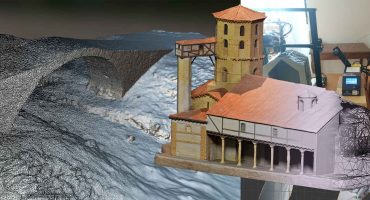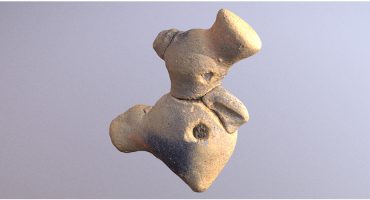PART III
Our Cultural institutions Page highlights our ongoing support of museums and cultural institutions with free accounts and access to tools. In Cultural Heritage Spotlight, we’ll explore museums and cultural institutions who are using 3D technology to bring new life to their collections. Today’s blog post features Daniel Pett’s effort to make the collections of the British Museum accessible for anyone in 3D and VR.
In the last part of Daniel Pett question and answer, the Senior Digital Humanities Manager at the British Museum gives feedback about people’s reaction to this new medium, and give his thought on next steps for 3D and VR.
8/ How have the reactions of the audience and the British Museum team been to this new medium?
Audience reaction has been quite interesting, but not really researched (there’s a Master’s thesis here if anyone is interested). There was the initial surge in interest and massive view counts for the very first models that were released (which looking back at with Thomas Flynn, we have decided all need redoing), but generally we have seen a long tail model of interest. The majority of models have very low views and we haven’t got great upsurge in usage even when associated news stories make the mass media (for instance the Jericho Skull or the Virgin and Child acquisition). Both of the articles cited here could have used our 3D content live and embedded, but didn’t. An opportunity lost.
Amongst colleagues, I think there is still a view that 3D is a nice thing, but still a bit of a luxury and comes with the question what does it achieve. For instance, have a look at commentary by Mark Carnall on Twitter for instance, when it comes to 3D, I think he’s spot on, and educated skeptic! Unless 3D content actually works in more ways than just a spinning object, what’s the point?
Ideally I would like far more exposure for our 3D output on our various interaction platforms – higher volume of embeds on Facebook and Twitter, more joined up usage of models when objects are mentioned in newspaper stories (we should push the use of our models via embeds as a way of enhancing content.) Of course there are a variety of tensions in the way, winning places within the social media schedule is not easy when the BM is so multifaceted; there is always something going on.
In many ways, our 3D models can push towards the Create Once, Publish Everywhere model that is often discussed at museum conferences.
9/ Do you wish to reach a particular audience with these models or do you think it is aim to everyone?
Like all of our content that we produce (analogue and digital) there’s always the tension over audience consumption. We’re now doing far more user research on what we produce in the museum context, but this has not yet turned to the 3D output, so we perhaps do not have the best metrics and analysis to inform the decision makers yet. The number of followers we have is still tiny in the grand scheme of things – and the same could be said for all our social media platforms – until we reach millions we’re not spreading the gospel of museums far enough.
For me, the 3D content we produce has multiple audience levels that can be seen as the consumer; the specialist, the browser, the serendipitous stumbler. As I mentioned earlier, I’m most excited about seeing how people reuse our content, by making our models downloadable (even under non-commercial terms) it allows others to build on our work.
Archaeology has generally been ahead of museums and digital humanities in most computational techniques for a long time now, and there’s some brilliant exemplars out there for inspiration. Take for example Professor Linda Hurcombe’s project and her suggestions of replacing objects taken off display with white prints. Just a quick search on a search engine will bring up loads of archaeological research projects that will make you think.
10/ Could you imagine what is the next step for the British Museum regarding 3D and VR?
I don’t think I need to imagine 3D/VR steps for the British Museum, things are happening right now and some projects have been deployed already. We’ve had 2 successful small scale VR/360 immersive projects that were created with Soluis Heritage; the Bronze Age Round House and most recently the African Rock Art project’s ‘Game Pass Shelter’ app for iOS and Android. There has also been some experimentation in house with the use of Unity to create environments and this may continue and there’s some large scale (in terms of object size, not project staff) scanning currently underway within our America, Oceania and Africa department led by Jago Cooper. Some of my colleagues have previously worked with Gamar on the Gift for Athena app and we have experimented with the use of Augment for gallery text labels and bringing more content to the viewer.
There’s some fantastic 3D content coming soon via collaborative project work with the Art Research Centre from Ritsumeikan University on a small part of the Museum’s fabulous Netsuke model collection, and annotated archaeological site representation from the Amara West team led by Neal Spencer.
Bringing more people on board, devolving responsibility for asset creation – that is the next logical step as our crowdsourcing efforts have shown. If you look at Scan the World’s British Museum collection, they have produced far more models than we can achieve with a very small team. So over the last few months, between Tom Flynn and myself, we have taught museum curators and colleagues how to use our workflow to create our own models – Marcel Maree is capturing statues of Sekhmet, Jamie Fraser has been working on Levantine material, Anna Garnett has worked on Amara material and Jennifer Wexler has learnt and produced Horus and is now teaching others.
Anyone can make 3D models, we cannot stop the public coming in and doing so if they have the basic equipment and online 3D creation apps. (Our terms and conditions of entry prevent commercial use of photographs and 3D models made within the Museum campus.) Take a look at the work of Cosmo Wenman for example for someone who has captured British Museum objects to good effect, and the amazing stuff Tom Flynn has done like the Amitābha Buddha from Hancui.
Experimentation has also been ongoing within the Samsung Digital Discovery Centre led by Juno Rae and Lizzie Edwards (which builds on the work of Shelley Mannion, Kath Biggs and Faye Ellis) bringing 3D, AR and VR to our younger audiences. (As an aside, Kath Biggs printed our very first MicroPasts model in the Great Court of the Museum in bright blue plastic and I now use this piece to scrape ice off the car!)
There are also various other VR projects in production right now, you might see them by the time that this Q&A is published, but I cannot discuss these now. In the future, I can see more of our content being used to recreate ancient archaeological environments in the exhibition space – for example destroyed secular architecture and situating are collection into people’s imaginations. We may see more of the type of work that Stuart Eve did whilst completing his PhD at UCL as well (http://www.dead-mens-eyes.org).
11/ Do you have a fun fact to share about one of your model and/or a model that you particularly want to highlight?
The Jericho Skull was a fantastic model to create and came about from having lunch with the curator, Sally Fletcher, who said that it was off display and if I had time to scan it, I could do it. So on the same day, I took photographs (Tom Flynn did the same with the statue of Idrimi, King Alakah for Jamie Fraser, lunchtime chat, photographing at 5pm!) and processed the model overnight and it was ready the next day. The skull is one of the most amazing objects in the British Museum’s Middle East holdings and it was such a privilege to get access to it. However, saying that, I and my colleagues are so lucky to work in the Museum and to be given access to all of the amazing things that we have.
Thank you for asking me such a wide range of questions, if people have further questions you can always find me on Twitter.
You’re welcome Daniel! Thank you very much for your time and for the precious information and highlights you gave us.
If you are part of a cultural institution, get in touch with us at museums@sketchfab.com to set up your free business account



